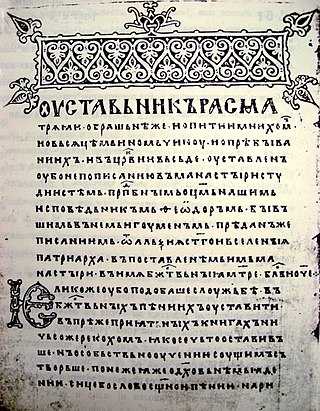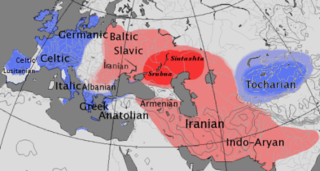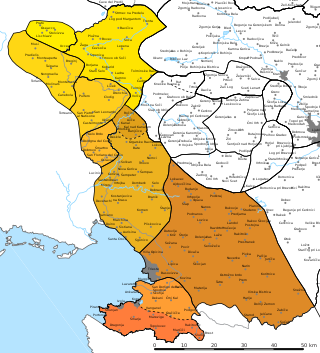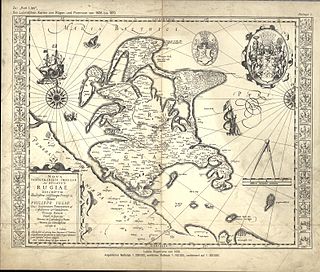Related Research Articles

The Slavic languages, also known as the Slavonic languages, are Indo-European languages spoken primarily by the Slavic peoples and their descendants. They are thought to descend from a proto-language called Proto-Slavic, spoken during the Early Middle Ages, which in turn is thought to have descended from the earlier Proto-Balto-Slavic language, linking the Slavic languages to the Baltic languages in a Balto-Slavic group within the Indo-European family.

Old Church Slavonic or Old Slavonic was the first Slavic literary language.
The Lechiticlanguages are a language subgroup consisting of Polish and several other languages and dialects that were once spoken in the area that is now Poland and eastern Germany. It is one of the branches of the larger West Slavic subgroup; the other branches of this subgroup are the Czech–Slovak languages and the Sorbian languages.

The soft sign is a letter in the Cyrillic script that is used in various Slavic languages. In Old Church Slavonic, it represented a short or reduced front vowel. However, over time, the specific vowel sound it denoted was largely eliminated and merged with other vowel sounds.
Russian is an East Slavic language of the Indo-European family. All Indo-European languages are descendants of a single prehistoric language, reconstructed as Proto-Indo-European, spoken sometime in the Neolithic era. Although no written records remain, much of the culture and religion of the Proto-Indo-European people can also be reconstructed based on their daughter cultures traditionally and continuing to inhabit most of Europe and South Asia, areas to where the Proto-Indo-Europeans migrated from their original homeland.
In Slavic languages, iotation is a form of palatalization that occurs when a consonant comes into contact with the palatal approximant from the succeeding phoneme. The is represented by iota (ι) in the early Cyrillic alphabet and the Greek alphabet on which it is based. For example, ni in English onion has the sound of iotated n. Iotation is a phenomenon distinct from Slavic first palatalization in which only the front vowels are involved, but the final result is similar.
The history of the Slavic languages stretches over 3000 years, from the point at which the ancestral Proto-Balto-Slavic language broke up into the modern-day Slavic languages which are today natively spoken in Eastern, Central and Southeastern Europe as well as parts of North Asia and Central Asia.
The phonological system of the Polish language is similar in many ways to those of other Slavic languages, although there are some characteristic features found in only a few other languages of the family, such as contrasting postalveolar and alveolo-palatal fricatives and affricates. The vowel system is relatively simple, with just six oral monophthongs and arguably two nasals in traditional speech, while the consonant system is much more complex.
The phonology of the Proto-Indo-European language (PIE) has been reconstructed by linguists, based on the similarities and differences among current and extinct Indo-European languages. Because PIE was not written, linguists must rely on the evidence of its earliest attested descendants, such as Hittite, Sanskrit, Ancient Greek, and Latin, to reconstruct its phonology.
The Old Polish language was a period in the history of the Polish language between the 10th and the 16th centuries. It was followed by the Middle Polish language.
The Slavic liquid metathesis refers to the phenomenon of metathesis of liquid consonants in the Common Slavic period in the South Slavic and West Slavic area. The closely related corresponding phenomenon of pleophony occurred in parallel in the East Slavic languages.
The following list is a comparison of basic Proto-Slavic vocabulary and the corresponding reflexes in the modern languages, for assistance in understanding the discussion in Proto-Slavic and History of the Slavic languages. The word list is based on the Swadesh word list, developed by the linguist Morris Swadesh, a tool to study the evolution of languages via comparison, containing a set of 207 basic words which can be found in every language and are rarely borrowed. However, the words given as the modern versions are not necessarily the normal words with the given meaning in the various modern languages, but the words directly descended from the corresponding Proto-Slavic word. The list here is given both in the orthography of each language, with accent marks added as necessary to aid in pronunciation and Proto-Slavic reconstruction. See below for a capsule summary of how to pronounce each language, as well as some discussion of the conventions used.

Languages of the Indo-European family are classified as either centum languages or satem languages according to how the dorsal consonants of the reconstructed Proto-Indo-European language (PIE) developed. An example of the different developments is provided by the words for "hundred" found in the early attested Indo-European languages. In centum languages, they typically began with a sound, but in satem languages, they often began with.

The Natisone Valley dialect, or Nadiža dialect, is a Slovene dialect spoken mainly in Venetian Slovenia, but also in a small part of Slovenia. It is one of the two dialects in the Littoral dialect group to have its own written form, along with Resian. It is closely related to the Torre Valley dialect, which has a higher degree of vowel reduction but shares practically the same accented vowel system. It borders the Torre Valley dialect to the northwest, the Soča dialect to the northeast, the Karst dialect to the southeast, the Brda dialect to the south, and Friulian to the west. The dialect belongs to the Littoral dialect group, and it evolved from Venetian–Karst dialect base.

Proto-Slavic is the unattested, reconstructed proto-language of all Slavic languages. It represents Slavic speech approximately from the 2nd millennium BC through the 6th century AD. As with most other proto-languages, no attested writings have been found; scholars have reconstructed the language by applying the comparative method to all the attested Slavic languages and by taking into account other Indo-European languages.
This glossary gives a general overview of the various sound laws that have been formulated by linguists for the various Indo-European languages. A concise description is given for each rule; more details are given in their articles.
The Proto-Slavic language, the hypothetical ancestor of the modern-day Slavic languages, developed from the ancestral Proto-Balto-Slavic language, which is the parent language of the Balto-Slavic languages. The first 2,000 years or so consist of the pre-Slavic era, a long period during which none of the later dialectal differences between Slavic languages had yet happened. The last stage in which the language remained without internal differences that later characterize different Slavic languages can be dated around AD 500 and is sometimes termed Proto-Slavic proper or Early Common Slavic. Following this is the Common Slavic period, during which the first dialectal differences appeared but the entire Slavic-speaking area continued to function as a single language, with sound changes tending to spread throughout the entire area. By around 1000, the area had broken up into separate East Slavic, West Slavic and South Slavic languages, and in the following centuries it broke up further into the various modern Slavic languages of which the following are extant: Belarusian, Russian, Rusyn and Ukrainian in the East; Czech, Slovak, Polish, Kashubian and the Sorbian languages in the West, and Bulgarian, Macedonian, Serbo-Croatian and Slovenian in the South.
Palatalization is a historical-linguistic sound change that results in a palatalized articulation of a consonant or, in certain cases, a front vowel. Palatalization involves change in the place or manner of articulation of consonants, or the fronting or raising of vowels. In some cases, palatalization involves assimilation or lenition.
The West Lechitic dialects are a group of extinct Lechitic dialects, used by the Slavic peoples of Pomerania, Margraviate of Brandenburg, Mecklenburg and the lands on the lower and middle Elbe. At the same time, the dialects of Central Pomerania and Gdańsk Pomerania are usually considered transitional between West Lechitic and East Lechitic and are called the Middle Lechitic dialect group.

The Rani dialect or Lechito-Rani supradialect is an extinct Slavic Lechitic dialect used by the Rani tribe – the medieval Slavic inhabitants of the island of Rügen and its opposite coast. This dialect, because of its closer affinity to the Drevani language than to the Pomeranian area, should be classified as a West Lechitic dialect.
References
- 1 2 Papierkowski 1930, p. 120.
- 1 2 Papierkowski 1930, p. 73.
- ↑ Papierkowski 1930, p. 111-113.
- ↑ Papierkowski 1930, p. 112-113.
- ↑ Papierkowski 1930, p. 113.
- ↑ Papierkowski 1930, p. 114.
- 1 2 Papierkowski 1930, p. 115.
- ↑ Papierkowski 1930, p. 115-116.
- ↑ Papierkowski 1930, p. 116.
- 1 2 Papierkowski 1930, p. 117.
- ↑ Papierkowski 1930, p. 117-118.
- ↑ Papierkowski 1930, p. 118.
- 1 2 Papierkowski 1930, p. 110.
- ↑ Papierkowski 1930, p. 118-119.
- ↑ Papierkowski 1930, p. 106-107.
- ↑ Papierkowski 1930, p. 109.
- 1 2 Papierkowski 1930, p. 103.
- ↑ Papierkowski 1930, p. 103-104.
- 1 2 Papierkowski 1930, p. 104.
- ↑ Papierkowski 1930, p. 104-105.
- ↑ Papierkowski 1930, p. 105.
- ↑ Papierkowski 1930, p. 105-106.
- 1 2 Papierkowski 1930, p. 119.